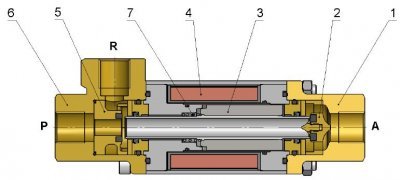News Letter
Sign Up & get 33% off your first order
Enter your preferred name & e-mail to subscribe

High and Medium Vacuum solenoid valves come in various sizes and forms or functionality, however for vacuum applications you can only use direct acting or assisted lift solenoid valves. Typically, you cannot use a servo or pressure assisted solenoid valve, even though you may have a pressure differential due to the vacuum on the outlet port, as this type of pressure assisted solenoid valve requires a positive inlet pressure to operate, you will find that the type of valve will fail to open if used incorrectly for vacuum applications.
Direct acting and assisted lift (hung diaphragm) solenoid valves do not require any pressure differential and will typically work well on most vacuum applications.
|
|
This is a 2/2 way direct acting solenoid valve schematic, basic Good Points: Compact, low cost, low energy consumption. Bad Points: Low flow (small orifice). Typical Port sizes from 1/8 through to 1/2" BSP, NPT Thread. |
|
|
This is a 2/2 way assisted lift or hung diaphragm solenoid Good Points: High Flow. Bad Points: Can sometimes give poor sealing on slight vacuum, higher energy consumption. Typical Port Sizes from 3/8 through to 2" thread BSP, NPT or DN25 to DN100 Flange |
 |
This is a 3/2 way direct acting coaxial solenoid valve. Also Typical port sizes 1/4 through to 2" thread in either BSP, NPT or DN10 to DN80 Flange. Good points: Compact, high flow, excellent sealing, mounting any direction, manifold options, open and closed position switch and manual override options. Bad Points: Typical, more expensive than a solenoid valve. |
Solenoid valves for vacuum applications can be made from the same materials as general purpose solenoid valves, typically Brass body, stainless steel internals and NBR seals. The only parameters of concern will be the environment, application temperatures and application requirements. For example for food industry vacuum applications a stainless steel body would be preferred and for high temperature applications PTFE or FKM seals and High a Temperature Class H (180C) or N (200C) rated coil will be required.
Helpful Hint: Always advise any application environmental and temperature parameters when ordering your vacuum solenoid valve.
Solenoid valves ports are usually marked on the ports either in and out or inlet and outlet or even simply 1 and 2, 1 denotes inlet 2 denotes outlets. Remember to connect the vacuum side of the process system to the outlet side of the solenoid valve or port 2, as you will be sucking out, not pressurising IN. So connect vacuum to port outlet port 2. (port 1 typically is the pressure or atmosphere inlet)
Vacuum solenoid valves are typically found in the Flat panel display, scientific instrumentation, industrial vacuum, process vacuum, research and development, semiconductor, emerging technologies, nanotechnology, steel degassing, lithium-ion and chemical process, vacuum press bagging, Resin infusion, vacuum distillation and petroleum distillation and Vacuum lifting industries.
View a full range of 2 and 3 way valves suitable for low, medium and high vacuum applications here.
A catalouge of articles covering all aspects of solenoid valves
Enter your preferred name & e-mail to subscribe